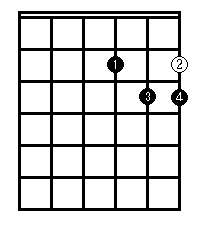
You can add texture and interest to a chord progression by using different types of chords. It's easy enough to move beyond simple major and minor chords by adding seventh notes, and you can also extend chords further to come up with 9th's, 11th's, etc. One of my favourite chord types, and one that's often overlooked, is the suspended chord.
Basically, a suspended chord has a root and fifth degrees, but instead of a third, there is either a second or a fourth 'suspended' between the other two notes. Because the usual pattern of thirds between the notes isn't present, the resulting chord has a very interesting sound. Also, there's no third (or flattened third) in there, so the chord has no 'major' or 'minor' characteristics.
These chords have the formula 1-4-5. For example, if you take the C major scale (C-D-E-F-G-A-B) and take the first, fouth and fifth degrees of the scale (C-F-G) you get the notes that make up the Csus4 chord.
Another really common shape for the sus4 chord is shown below. This one is Dsus4, and it's the shape that Brian May uses in the famous D/Dsus4 combination in for Queen's "Crazy Little Thing Called Love".
 |
This is built on a very familiar major
chord shape, with the fourth finger placed on to provide
the suspended 4th note in place of the major third. Alternating between the basic major chord and the sus4 chord with the same root note is quite a common technique. As well as the Queen example mentioned just before, check out the intro for "Start Me Up" by the Rolling Stones, or (if you prefer something with a bit more overdrive) it also crops up in Gun's version of "Word Up" (F#/F#sus4 to E/Esus4). |
These chords are a little less common, but they have a great sound. As the name implies, they include the 2nd degree of a scale, which is 'suspended' between the root and fifth. The formula for this type of chord is 1-2-5, so if we use the C major scale as an example again, the first, second and fifth degrees of that scale would give us C-D-G.
A useful fingering for this chord is shown below - this is Csus2, played at the third position:
There are a number of different ways of playing sus2 and sus4 chords - experiment with chord shapes that you know, but move the third (or flattened third, in the case of minor chords) up to a second, or down to a fourth. Experiment with different inversions, and try to incorporate them into your own playing.
Remember: suspended chords never include a third (or flattened third) degree - if they do then they cannot be suspended chords. For example, the notes C-E-F-G would be called C add 4, because it is a C major triad with an added fourth (some people might also call it C add 11, but it comes down to the same thing).
How useful did you find this tutorial?
| Product/Info... | PhatPhish Application | | | Product Help | | | GUPPY - PhatPhish for the web | | | About The Author |
|---|
| Get Stuff... | Download PhatPhish | | | Mechandise | | | Blank Stave And Tab Sheets | | | Tutorials |
|---|
| Do Stuff... | Register | | | Feedback | | | Links | | | Donate | | | Ask A Question |
|---|
| Social Media... | YouTube | | | | |
|---|
| Promote... | Spread The Word | | | Posters/Flyers |
|---|
| Play... | PhatPhish Picks - Boutique Plectrums |
|---|
| ©2002-2022, Dave Dixon / CyberFlotsam http://www.cyberflotsam.com |